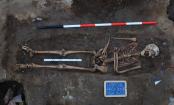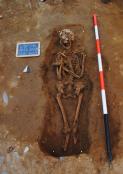CAMPAGNA 2014 |
1° SETTIMANA |
2° SETTIMANA |
3° SETTIMANA |
4° SETTIMANA |
5° SETTIMANA |
6° SETTIMANA |
7° SETTIMANA |
8° SETTIMANA |
28 LUGLIO 2014 
Resoconto della giornata di scavo
Area 2000
All’interno del Settore A è proseguita la messa in luce di USk 2498; l’individuo orientato W/E prosegue al di sotto di USM 2358 e ciò rende possibile collegarlo a fasi antecedenti al cimitero ottocentesco e probabilmente medievali. Durante lo scavo della sepoltura è stato necessario rimuovere il lacerto pavimentale in mattoni (US 2501) ancora evidente all’interno della ‘vasca laterizia’ USM 2106, il quale copriva parzialmente il bacino e gli arti superiori dello scheletro in connessione. Ciò ha dato modo di osservare le diverse fasi d’uso e di sistemazione della struttura: un primo pavimento (US 2501) in mattoni squadrati e senza uso di malta, associato ad USM 2358, su cui è stata effettuata una seconda pavimentazione con laterizi di medie e piccole dimensioni legate con malta, ed infine una terza fase di rivestimento con mattoni rettangolare posti a spina di pesce. A nord, a ridosso del punto dove USM 2358 si interrompe, vi è un allineamento di quattro mattoni quadrati e regolari che potrebbero essere interpretati come soglia. Nonostante queste osservazioni non risulta ancora chiara la funzione originaria di tale imponente ed estesa struttura.
Nell’Area 1000 è terminata la rimozione di Usk 1310 nella porzione centro settentrionale. L’individuo si è conservato malamente e rimangono visibili il cranio in norma laterale sinistra, le diafisi degli omeri e degli avambracci, alcune vertebre toraciche, cervicali e lombari, frammenti del sacro e del bacino e gli arti inferiori distesi paralleli. La pulizia generale effettuata nella metà più meridionale ha evidenziato tre tagli circolari, quasi allineati, nell’angolo SO all’interno dei quali sono stati trovati frammenti ceramici medievali (UUSS -1330, -1332, -1334). Subito ad Est di questi è stato identificato un taglio sepolcrale orientato OE, avente forma allungata regolare (US -1313). Il riempimento è stato solo parzialmente rimosso ma ciò ha comunque permesso di individuare lo scheletro in connessione USk 1319, in ottimo stato di conservazione, e di capire la posizione assunta al momento della morte: l’individuo è stato deposto in decubito dorsale, con gli arti superiori leggermente flessi, il cranio in norma frontale e gli arti inferiori distesi paralleli. Interessante notare che all’esterno sia lungo il lato corto occidentale che quello orientale sono state evidenziate due piccole buche di palo (UUSS -1321, -1319), aventi un diametro tra gli otto e i dieci centimetri, che potrebbero essere relazionate alla presenza di un segnacolo in legno che indicava la presenza della sepoltura.
Today, we finished excavating the burial in the northwest corner of Area 1000. In addition the burial that was just west of that burial, which was removed Friday, two tibias were found that would have been in connection. Also, a new medieval cut was explored in the southwest corner and a skeleton was exposed. In addition, a round cut, in the center of 1000B was explored. It was found that there was a thick layer of the clay charcoal in the cut. It is unclear what this feature could be. Several other small, round cuts were explored in both 1000B and 2000B. Within these cuts, no material culture or bones were found. In 2000B, another cut was explored, oriented east-west. It is cut by both the wall and a cholera burial cut. Thus far, no skeleton has been discovered, but it is suspected to be a burial. Within the brick structure if 2000A, the bones were further exposed. Also, some bricks of the brick structure were removed, to determine if the burial was cut by the structure or continued under it. It was found that it continues under the wall of the brick structure. Tomorrow, it will be continued to be exposed.
Area 3000
La sesta settimana di scavo si è aperta con la messa in luce completa degli inumati USK 3452 ed USK 3463, entrambi orientati N-S e deposti in decubito dorsale rispettivamente nella porzione centro-settentrionale e nord-occidentale del Settore B. In particolare USK 3452 è un individuo adulto di sesso maschile in buono stato di conservazione, sepolto all’interno di una cassa lignea, come suggerisce la forma sub-rettangolare della fossa sepolcrale ed il rinvenimento di alcuni chiodi lungo i margini interni del taglio. Il cranio è in norma laterale destra, l’arto superiore destro è leggermente flesso sul pube, mentre quello sinistro è flesso sull’addome; gli arti inferiori sono distesi, con il destro leggermente ruotato verso ovest. Le ginocchia e le caviglie sono aperte, con i piedi divergenti ed appoggiati alla parete meridionale della tomba. USK 3463 è invece un individuo di sesso femminile e di età avanzata, probabilmente deposto anch’esso in una cassa; il cranio, piuttosto frammentario, è in apparizione frontale, leggermente in norma laterale sinistra; l’arto superiore destro è ripiegato su se stesso con la mano in posizione palmare, mentre quello sinistro è flesso sull’addome, con la mano sovrapposta all’altra. Gli arti inferiori sono distesi, con le ginocchia chiuse. Lo scheletro è stato intercettato ed asportato al di sotto delle epifisi prossimali delle tibie, probabilmente dalla trincea ottocentesca US – 3386. Ad est di USK 3463 è stata inoltre messa in evidenza la riduzione parziale di resti osteologici (US 3466) appartenente ad un individuo adulto di sesso maschile. Nella porzione meridionale del settore si è proceduto con la pulizia generale dell’area, che ha portato all’individuazione di altre fosse sepolcrali che saranno indagate nei giorni seguenti.
The day started with exposing, documenting, and removing the skeleton (3452) located in the north central section of Sector B. A new cut was found in the north central section of Sector B that contained a partial reduction and a burial underneath the reduction. However, the burial was not exposed yet. The skeleton (3463) was further exposed, documented, and removed for analysis. Skeleton 3463 had a miscellaneous articulated hand underneath the left humerus that will be exposed in the future and overall displayed wall effect. The rest of the day was spent cleaning the south section of Sector B, as well as cleaning the lithic coffins. We plan on cleaning the rest of the southern half of Sector B and exploring other cuts later in the week.
Area 4000
Stanno terminando in questi giorni le ultime indagini relative all’area 4000, con la messa in luce della sepoltura USk 4821 nell’angolo nord-occidentale del settore A. I dati a nostra disposizione riguardo la storia del chiostro dell’abbazia di San Pietro sono tali da permettere una precisa ed accurata ricostruzione della vita del monastero e di chi in esso viveva. Sono stati inoltre raggiunti gli strati di terreno sterile che costituiscono la base su cui tutte le successive attività antropiche si sono, nei secoli, impostate. Alla luce di ciò l’area 4000 sarà definitivamente chiusa, in favore di un nuovo fronte di indagine su quello che un tempo era il sagrato della chiesa di Badia Pozzeveri, l’area 6000.
Today at Field School Pozzeveri we finished most of the work in Area 4,000. We troweled the context in the morning, and then removed USK 4223. We also worked on USK 4821, exposing the bottom of the cut and pedestalling the bones. The only thing left to do in Area 4,000 is take photos of USK 4821 and remove the skeleton. After four years of excavation, we have reached the bottom of the context. We determined that we have found the bottom of the context because we have found the burials of the monks, and the burials were below the paleosuface of the cloister hall. After working in Area 4,000, we began work on opening a new area in front of the old church façade, using pick axes to clear debris left by a back hoe. This area is currently referred to as Area 6,000. We
believe this is a garden area which was a place of high activity. We expect to find many burials from the 15th century in this newly opened area.
Area 5000
Oggi è stata messa in luce e scavata una buca piuttosto grande nella porzione occidentale dell'area (US 5131) posteriore rispetto ad una chiazza di terreno termotrasformato. Altre chiazze simili sono state individuate anche nella porzione più orientale dell'area e una di esse sembra tagliata dalla struttura muraria USM 5117. E' stata messa in evidenza, inoltre, un ulteriore porzione di questo muro verso nord. Per adesso è visibile solo la traccia lasciata dalla malta in disfacimento tipica della cresta di rasatura. Infine nella zona centro orientale dell'area stanno emergendo alcuni piccoli tagli regolari. Una pulizia totale dell'area di scavo sarà utile al fine di comprendere meglio la complessa situazione che emerge giorno dopo giorno.
Today in area 5000 we finished the excavation of the trench from the modern day water pipe. Upon noticing that the cut through the northern wall was wider than the rest of the trench, we excavated this cut and fill. After the removal of the fill, it was determined that the widening of the trench was a necessity due to the size of rocks that comprised the wall. In the south western edge of the site there was some interesting soil colorations that were investigated. This area needs further exploration. We continued exploring the cuts around the medieval wall running north-south in the center of area 5000. Three more holes were uncovered on both sides of the wall. One of the holes revealed contemporary objects which are believed to come from the modern day water trench. The purpose of these holes are not certain, but we hypothesize that they were created due to construction and leveling. Along the northern half of the site, the layer was taken down to a flat level and commenced cleaning for photographs and analysis tomorrow morning.













